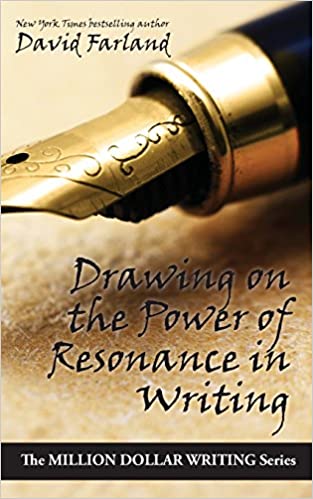
All successful writers incite resonance in their readers. They may not be consciously aware of what they’re doing–or even know the meaning of the word–but they wouldn’t be successful otherwise. In this blog post, I’ll try my best to define what resonance is, why it’s so important and how you can implement it to affect readers so deeply that your stories will stick with them for years to come.
Definition
Resonance is “drawing power from what came before,” as David Farland writes in Drawing on the Power of Resonance in Writing. This occurs in every medium including music: a repetition of notes from earlier in a symphony, a repeated refrain in a choir song, even the chorus in your favorite pop hit from 1969 is no exception!
Because of this repetition, we the audience notice it immediately and when we do, the familiarity brings out a ‘reverberation’ from within us. Many times it’s not so obvious in writing, but it’s still there–and when we come upon it, deep folds within our brain activate and vibrate in a nostalgic sort of buzz. If that sounds weird that’s because it is: this is a deep feeling within our subconscious mind. People aren’t just comfortable with the familiar–they enjoy it!
Writing successful stories has a lot to do with reintroducing themes and literary devices to readers in a different way and in a different package. If you ever wondered why tropes exist, this is why. Your characters, tones, imagery and even story structure can (and should) all resonate within.
First Things First
No work is truly original. Most creators accept this, but to truly understand resonance you have to embrace it. Just as The Wheel of Time by Robert Jordan was inspired from The Lord of the Rings by J.R.R. Tolkien, Tolkien himself was inspired by the epic poem Beowulf: Grendel and her mother were inspiration for orcs, the Men of Rohan were very similar to Anglo-Saxons, and both had dragons upset by stolen chalices.
Game of Thrones borrowed from the Wars of the Roses–which The Wheel of Time did, too, as did Samurai of Hyuga Book 4! It was no mere coincidence that the Uesugi Clan wore white armbands while the Takeda wore red!
Here is a list of some of the inspiration in my works:
- Azorus IV was inspired by Martian Successor Nadesico.
- StockBreaker was inspired by Wall Street Kid and the 2011-2012 political season.
- Fatehaven was inspired by Fable and the Garret P.I. series.
- SoH Book 1 was inspired by Rurouni Kenshin’s Tokyo arc.
- SoH Book 2 was inspired by Hikaru no Go and Fantasy Island.
- SoH Book 3 was inspired by Detective Conan, Drifters and Kagemusha.
- SoH Book 4 was inspired by The Wheel of Time, Eyes Wide Shut and Avatar: The Last Airbender.
Some of you may have noticed these influences while playing while others may have noticed just now. These inspirations range from anime, to news media, to television classics. We are all inspired by something as we write–being aware of this is one of the differences between amateurs and professionals. Like story structure, it doesn’t take the magic out of story writing, but instead clears up the mystery surrounding the process.
And the less time you spend worrying about the process, the more time you have to let your creativity flow out onto the page!
The Psychology Behind It
As we’ve seen in premise lines and beat sheets, all stories follow a similar structure. While at first glance it may seem limiting, in truth it’s flexible enough for every genre, every book in the bookstore that doesn’t have recipes, and every film on your hard drive–except for the lewd ones!
Story structure itself resonates with us as scientists are starting to find out. Storytelling is in our very nature: the way we interpret our experiences and retell our memories are done in story-form. We’re each biased narrators, of course, which is why we’re able to have such radically different opinions and worldviews in the first place! Science may one day discover the roots of the Hero’s Journey is our very DNA!
Stories allow us to share experiences and give form to concepts and ideas. This form may be imaginary or real: the freedom to sit at the front of the bus, for example, is given form by the real-life story of Rosa Parks. This abstract idea is given human form to which we can visualize and sympathize with. Americans were able to identify with her so much that this prompted civil change!
There is a lot of power in stories. Resonance helps you tap into that power, to create emotional connections with readers that to them is as real as anything else.
Implementation
Every writer whose given it some thought has a list of “Scenes I Want to Write”. Maybe some of them aren’t necessarily a scene, just a concept: like the idea of living on a train that has different social castes in it. Sounds like Snowpiercer, doesn’t it? Knowing and identifying what about a particular show, videogame or book resonated with you is the key.
You don’t need to know exactly why your subconscious mind resonated with that particular element. For all you know, it could’ve been some past life nonsense! What’s important is that you identify what “spoke to you” or “struck a chord”. Converting this into your own creation is what inspiration is all about.
Chances are, what excites you excites others, too. So find what resonates within and echo it throughout your work!


I was telling my sister about SoH Book 1 and she said it reminded her of Rurouni Kenshin. I guess she wasn’t wrong!
aspiring fiction writer here! i just finished book 3 of samurai of hyuga and i am very emotionally compromised! your work is inspirational to me, and I really can’t wait to read more!
I cannot wait to hear the Jun’s side of the story now, hope we will get more contents of him! 💗
Hey! I’m writing this almost a year after you published this post, but I have been browsing your website while waiting for SoH5, and I stumbled upon this.
I don’t really try to get the inspiration sources of a game I love, not to mention I tend to get it wrong. Like, something in SoH reminds me of Hamelin no Violin Hiki (the anime version), with a bit of Hyakka Hyakurou and maybe even a bit of Yo-Jin-Bo, none of these being on the list, so yeah…
But I would be curious to know your inspirations for Fatehaven, because you didn’t list it in your post, and it has been a huge source of inspiration to me over the years.
Anyway, I already said it before, but thank you for making great games!
Thanks for the comment and your patience for the next book!
There’s so much crossover and so many tropes shared by all pieces of media that it’s no surprise that aspects of SoH remind you of stuff I’ve never heard of, lol! If you play a crapton of otome games, for example, you’ll probably see some aspects of SoH that are similar, even though I’ve never played an otome in my life!
I can’t believe I forgot about Fatehaven! Even professional writers but especially amateurs don’t really pay any conscious thought about resonance or the inspiration in the scenes they write–they just write! That was very much me for Fatehaven. Looking back, though, the xbox game Fable probably inspired the starting segment of the game, while the city, the Redwater Mercenaries, and just the general feel came from the Garrett P.I. series.
Anyhow, thanks for reminding me about it! I’ll make sure to update the blogpost. And thanks for reading!